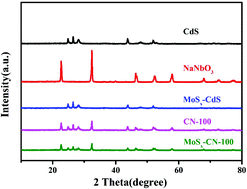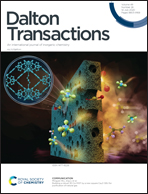Photochemical deposition of amorphous MoSx on one-dimensional NaNbO3–CdS heterojunction photocatalysts for highly efficient visible-light-driven hydrogen evolution†
Abstract
A novel ternary MoSx–CdS–NaNbO3 (MoSx–CN) photocatalyst was successfully fabricated through a two-step method (hydrothermal synthesis and photo-deposition step). The results demonstrated that CdS nanoparticles and amorphous MoSx uniformly dispersed on one-dimensional (1D) NaNbO3 nanowires, thus forming multi-junctions (CdS–NaNbO3, CdS–MoSx and NaNbO3–MoSx) that could increase the migration efficiency of photo-excited charge carriers. In addition, an abundance of unsaturated sulfur atoms in MoSx led to a strong attraction to H+, thus providing active sites for water splitting. Consequently, the optimized composite sample (MoSx–CN-100) exhibited a hydrogen (H2) evolution efficiency of 2.386 mmol g−1 h−1, which was about 125.58 and 11.93 times that of NaNbO3 and CdS, respectively. Moreover, the ternary photocatalyst also exhibited excellent stability in the long-term hydrogen production process compared with the binary and single samples. Our work provided new insight into the rational design of multi-heterojunction photocatalysts with high efficiency for H2 evolution under visible light irradiation.



 Please wait while we load your content...
Please wait while we load your content...